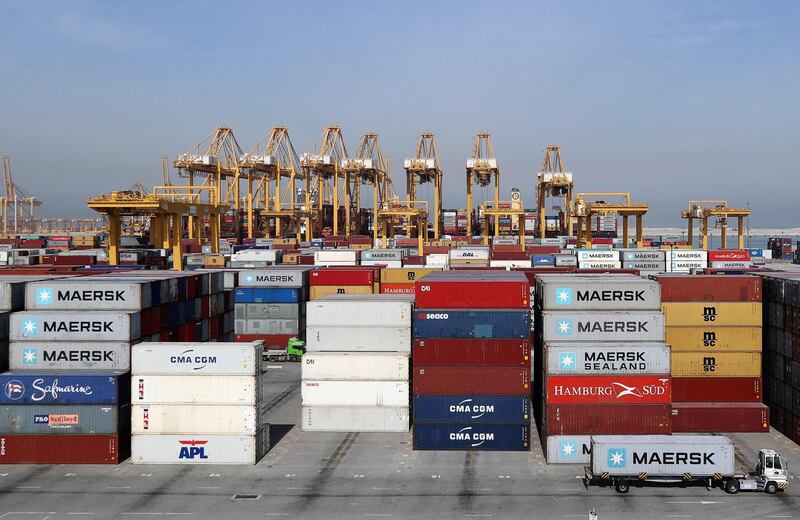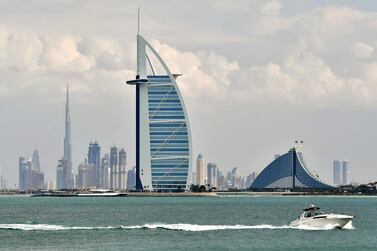Dubai’s non-oil external trade grew by 10 per cent in the first quarter of this year as its economy continued to recover on the back of a rapid vaccination programme and government stimulus measures.
Total foreign trade during the period stood at Dh354.4 billion ($96.5bn), compared to Dh323bn in the same period last year, the Dubai Media Office said on Saturday. It was up 5 per cent compared with the first three months of 2019.
Exports grew by 25 per cent to Dh50.5bn while imports rose by 9 per cent to Dh204.8bn. The value of re-exports was up 5.5 per cent to Dh99bn.
“This remarkable growth will get us closer to the ambitious target of Dubai’s five-year strategy – to raise the value of external trade to Dh2 trillion and consolidate its position as a bridge connecting regional and international markets by constantly enhancing its infrastructure and logistics services,” said Sheikh Hamdan bin Mohammed, Crown Prince of Dubai and chairman of the emirate’s Executive Council.
“By hosting Expo 2020 ... Dubai will make a significant contribution to the recovery of the global economy and help it move towards prosperity again.”
#Dubai’s economy has proved its resilience and ability to recover quickly from the global repercussions of the COVID-19 pandemic by achieving high levels of external non-oil trade growth in Q1 2021. pic.twitter.com/OwTjM5HkOk
— Dubai Media Office (@DXBMediaOffice) June 12, 2021
The economy of Dubai is expected to expand by 4 per cent this year, according to government projections released in December. The emirate has unveiled stimulus packages worth Dh7.1bn since the outbreak of Covid-19 to support the economy, businesses and people.
“Dubai recovered quickly from the repercussions of the current global crisis and has resiliently grown its trade, spurred by its strong investments and advanced technological capabilities, which enabled it to continue its global trading activities during what has been a testing time,” said DP World Group chairman and chief executive Sultan bin Sulayem.
“The impressive success of the vaccination campaign in the UAE has created high levels of global confidence in the country and helped Dubai add to its profile as the city with the world’s most favourable business environment.”
Direct trade during the quarter increased by 15 per cent annually to Dh217bn while trade through free zones was up 2 per cent to Dh135bn, according to the latest statistics. Customs warehouse trade grew by 23 per cent Dh2.3bn.
Airborne trade rose by 15 per cent to Dh179bn while sea trade grew by 3 per cent to Dh120bn and land trade by 7 per cent to Dh55.3bn.
China maintained its position as Dubai’s largest trade partner with Dh44bn worth of trade, followed by India and the US at Dh35bn and Dh15.4bn, respectively. Saudi Arabia, Dubai’s largest trade partner in the Gulf region and Arab world, was fourth on the global list with Dh14.7bn worth of trade. Turkey was fifth with Dh12bn in trade after a growth of 72 per cent during the quarter.
“We lead the way in connecting the east with the west and north with south through a number of leading global projects, including the World Logistics Passport, which Dubai launched to facilitate international trade exchange and build a global logistics network,” said Mr Bin Sulayem, who is also chairman of the Ports, Customs and Free Zone Corporation.
“The initiative provides economic advantages to member countries such as Indonesia, India, Thailand, South Africa and Brazil.”
In terms of products and services, gold topped the list of commodities after the value of trade in the metal grew by 27 per cent to Dh63bn during the reporting period, followed by telecoms, whose value grew by 32 per cent to Dh50bn.
Diamonds were third after record growth of 61 per cent that boosted trade value to Dh29bn., followed by jewellery at Dh17bn and vehicles trade at Dh14bn.
Global trade is expected to grow by 8 per cent this year as stimulus measures and spending plans buoy economic growth in the US and Europe.








